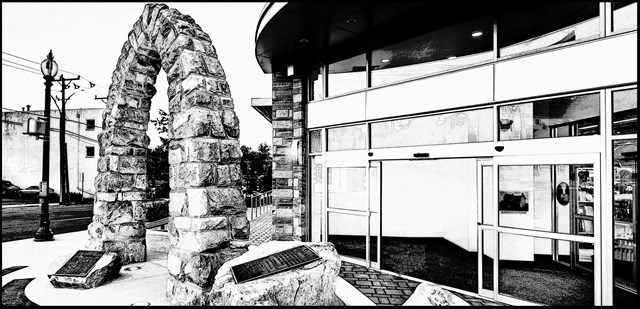This is an Earthcache – as such, there is no physical cache. Instead you will partake in a geology lesson by making observations and answering 3 questions about the Falls Church Trondhjemite at the posted coordinates. There are two street parking spots next to the GZ on Tinner Hill Road. Park responsibly and obey posted signs.
TINNER HILL ARCH
This 15 foot tall Roman arch was built in 1999 from pink stone that was originally quarried at the base of Tinner Hill by the Tinner family. The Tinners were African American stone masons who owned the land and cut much of the stone that was used in building construction in the early days of Falls Church.

When the old stone buildings were destroyed in the mid-20th century, many local families collected the stone debris for their own yards. In the mid 1990’s, Tinner Hill stones were gathered over a two year period from over 30 local property owners to build an arch to honor the men and women of Tinner Hill who formed the first rural branch of the NAACP.
GEOLOGY OF FALLS CHURCH
The State of Virginia is comprised of five different geologic provinces. They include the Appalachian Plateau, Valley and Ridge, Blue Ridge, Piedmont, and Coastal Plain. Each province is characterized by having different age and type of rocks exposed at the surface.

The city of Falls Church is in the Piedmont Province. This province is situated between the coastal plains to the east and the blue ridge to the west. The Piedmont consists primarily of the fragments of other continents or ocean crust that was swept up and plastered onto the North American continent during the process of tectonic plate collisions and separations. As a result, the piedmont is complex with highly folded and intricately sliced metamorphic and igneous rock formations.
Other than two small floodplains (See Qal on the map above), the geologic strata underlying Falls Church consist mostly of highly weathered rock and crystalline rock. Approximately two thirds of the city consist of metamorphic rock including gneiss, schist, and metagraywacke from the Sykesville Formation (See Cs on the map above). The southwestern portion of the City is dominated by an igneous mass of granitoid rock, from which this Tinner Hill pink trondhjemite was quarried (See Oftr on the map above).
TRONDHJEMITE
Trondhjemite (pronounced like "tron′gem'mīte") is intrusive igneous rock, meaning it is formed deep into the earth’s crust from slow cooling magma. The largest veins of this rock are found in Norway, Peru, and Alaska.
You can find texts referring to Falls Church trondhjemite as being a “pink granite,” but that isn't 100% true. Like granite it is an intrusive igneous rock which is very hard, crystalline, and is formed by the melting of continental rocks. When alkali feldspars are extracted from granite, it changes to granitoid, and then later it becomes trondhjemite with quartz as its major mineral.
Trondhjemite stones still have a typical granitic composition (quartz and feldspar), but it only contains a small portion of potassium feldspar. Since the plagioclase is in Trondhjemite is mostly in the form of oligoclase it is not considered a true granite.
It was in the 1970’s that a sample of Tinner Pink Granite was tested by Dr. Avery Drake of the U.S. Geologix Survey who ascertained the rock to be Trondhjemite. Like other trondhjemite’s found around the world, Falls Church trondhjemite has quartz as major mineral. It is present as more in more than 20% of the rock. Feldspar is present as plagioclase with 10% or less alkali feldspar, and amphiboles and pyroxenes are common accessory minerals. The Falls Church Trondhjemite of this arch gets its light color because it is an orthoclase-deficient stone with minor biotite as the only mafic mineral.
REFERENCES:
1. TINNER QUARRY ROCK: TRONDHJEMITE, Tinner Hill Heritage Foundation, website, tinnerhill.org
2. Falls Church Intrusive Suite, U.S. Geological Survey, mrdata.usgs.gov
3. Tonalite-trondhjemite-granodiorite, wikipedia.org
4. Simplified Geologic Map of Arlington County, Virginia, and Vicinity, maps.arlingtonva.us
5. Inventory of Historic Sites Nomination - Tinner Hill District, FAIRFAX COUNTY INVENTORY OF HISTORIC SITES , website, fairfaxcounty.gov
6. ENVIRONMENT FOR EVERYONE, Environmental Sustainability, Resilience, and Natural Resources Chapter of the City’s Comprehensive Plan, Appendix B: Natural Recource Base, Geology, Page 36, February 2020, fallschurchva.gov
LOGGING REQUIREMENTS:
To log this Earthcache: Read the geology lesson above. Answer all three questions posted below and send them via e-mail or messenger contacts on my Geocaching profile.
QUESTION 1. What is the major mineral that makes up Falls Church Trondhjemite?
QUESTION 2. Touch the trondhjemite. Describe the texture?
A) Pegmatitic - A pegmatitic texture is one in which the rocks crystals are about 1” long to larger.
B) Phaneritic - A rock with phaneritic texture has crystal grains large enough to be distinguished with the eye.
C) Aphanitic -Aphanitic texture consists of extremely small crystals.
QUESTION 3. Observe the arch stone and the stone mason blocks on the building behind the memorial. Do you believe that the stone that makes up this wall is trondhjemite?
OPTIONAL PHOTO: Posting a photo that readily indicates that you (and anyone else logging the find) are at the location.
 Awesnap has earned GSA's highest level:
Awesnap has earned GSA's highest level:

 Best Earthcache
Best Earthcache